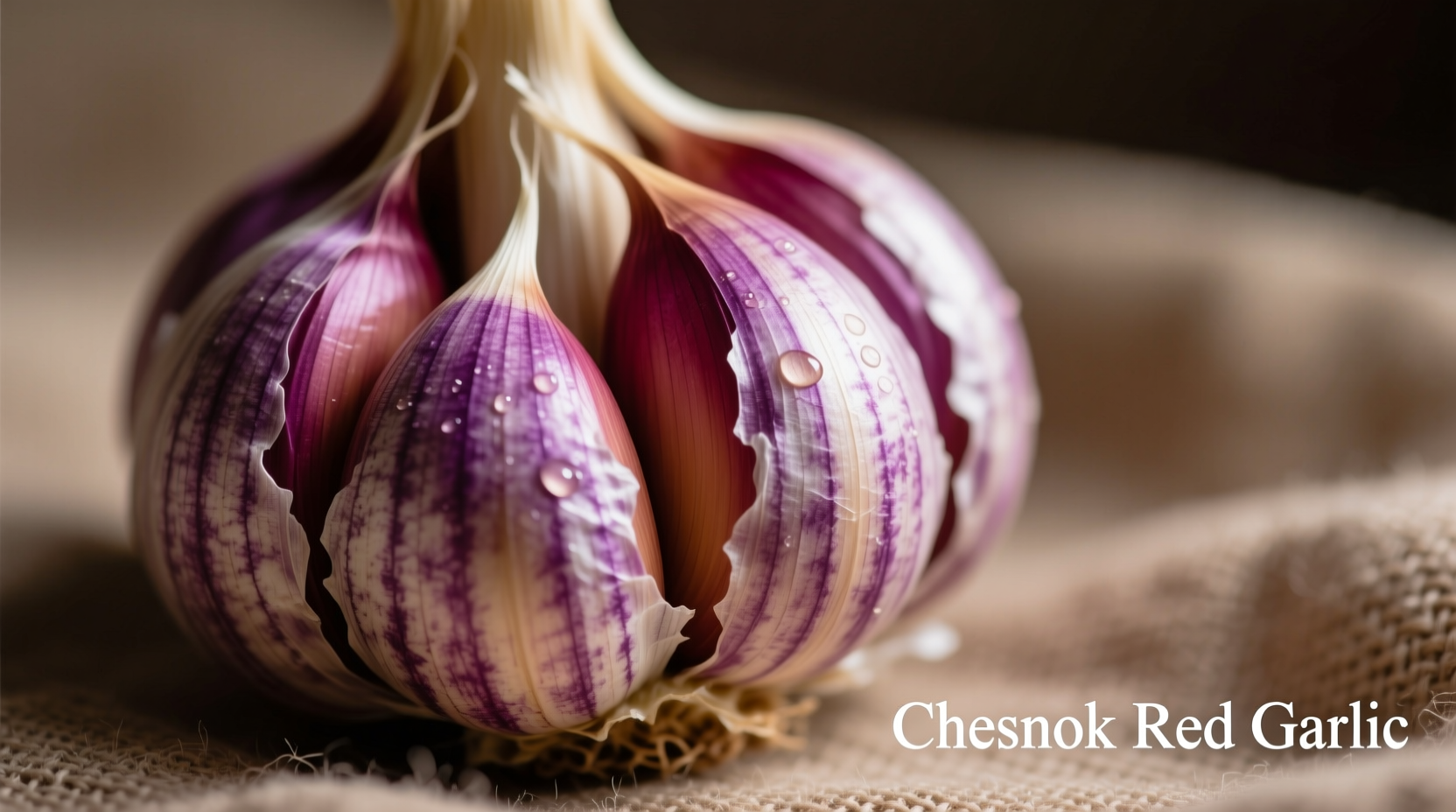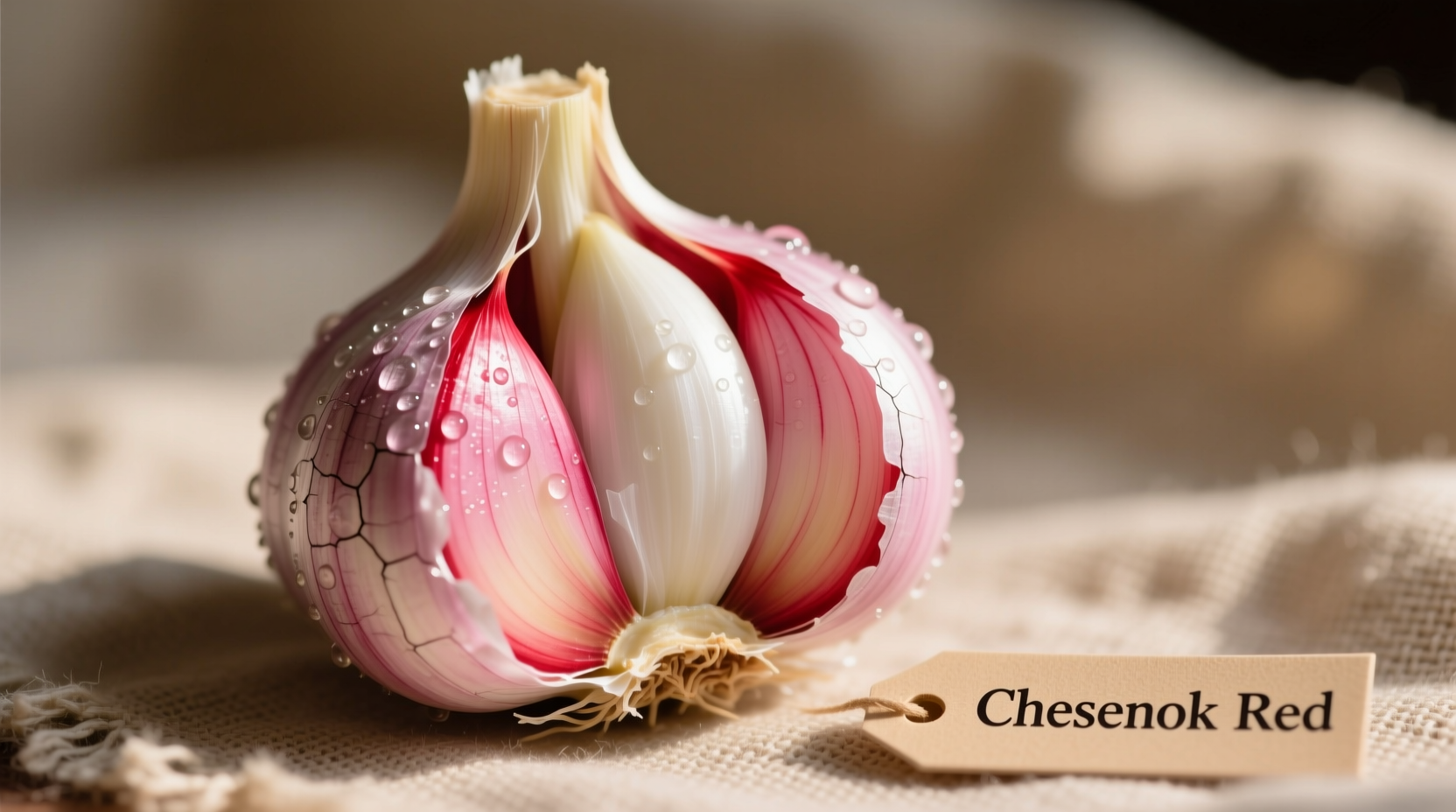Chesnok Red is a prized hardneck garlic variety (Allium sativum var. ophioscorodon) known for its striking purple-striped bulbs, large easy-to-peel cloves, and complex flavor profile that's milder when raw but develops rich, nutty notes when roasted. Unlike common supermarket garlic, this heirloom variety offers superior culinary versatility and grows best in cooler climates with proper winter chilling.
As a chef who's studied European spice traditions for over 15 years, I've seen how the right garlic variety can transform dishes from ordinary to extraordinary. Chesnok Red isn't just another garlic—it's a culinary secret weapon that professional chefs increasingly reach for when they want balanced flavor without overwhelming heat. In this guide, you'll discover exactly why this heirloom variety deserves a place in your kitchen and garden.
What Makes Chesnok Red Garlic Special
Chesnok Red belongs to the hardneck garlic family, which means it produces a central flowering stalk (scape) that must be removed to direct energy into bulb development. Originating from the Caucasus region, this variety made its way to the UK where it was named after the village of Chesnok. Unlike the softneck garlic dominating supermarkets, hardnecks like Chesnok Red offer more complex flavors and are easier to peel—but require specific growing conditions.
| Characteristic | Chesnok Red | Regular Supermarket Garlic |
|---|---|---|
| Bulb Appearance | Vibrant purple stripes on white skin | Uniform white or off-white |
| Clove Size | Large, easy-to-peel cloves (4-6 per bulb) | Smaller, numerous cloves (10-20 per bulb) |
| Flavor Profile | Mild when raw, rich and nutty when cooked | Sharper, more pungent heat |
| Storage Life | 5-7 months | 9-12 months |
| Growing Requirement | Requires cold period (winter chill) | Grows in warmer climates |
Identifying Chesnok Red Garlic
When selecting Chesnok Red, look for bulbs with distinctive purple striping across the outer wrappers. The cloves themselves will have a pinkish-purple hue beneath their papery skin. Mature bulbs typically measure 2-3 inches in diameter with 4-6 large cloves arranged symmetrically around a central stem. The scapes (flower stalks) spiral elegantly and are edible when young—a seasonal delicacy many home growers miss.

Culinary Applications That Shine
Chesnok Red's balanced flavor makes it incredibly versatile in the kitchen. Unlike more aggressive garlic varieties that can dominate dishes, Chesnok Red provides aromatic depth without overwhelming other ingredients. I recommend using it:
- Raw applications: Its milder raw flavor works beautifully in salad dressings, aiolis, and bruschetta where regular garlic might be too harsh
- Roasting: Develops complex nutty notes—try whole roasted heads with olive oil and herbs
- Sauces and soups: Provides foundational flavor without the sharp aftertaste of common garlic
- Pickling: The large cloves maintain texture better than smaller varieties
Professional chefs particularly value Chesnok Red for dishes where garlic should complement rather than dominate, such as delicate fish preparations or refined vegetable dishes. The University of Vermont Extension notes that hardneck varieties like Chesnok Red contain different allicin compounds that create more nuanced flavor development during cooking compared to softneck types (UVM Extension, 2023).
Growing Chesnok Red Successfully
If you're gardening in USDA zones 3-7, Chesnok Red will thrive with proper care. Plant individual cloves pointy-end up, 2 inches deep and 6 inches apart, in well-drained soil amended with compost. The critical factor is providing adequate winter chilling—this variety requires at least 40 days below 40°F (4°C) to form proper bulbs.
Timing matters: plant in fall (4-6 weeks before first frost) for harvest the following summer. As the plants grow, remember to cut the scapes when they make their first full loop—this redirects energy to bulb development. Harvest when the lower third of leaves turn brown, typically late June to early July in northern climates.
Storage Guidelines for Maximum Freshness
Unlike supermarket garlic bred for long storage, Chesnok Red has a more limited shelf life of 5-7 months. Cure bulbs for 2-3 weeks in a warm, dry, well-ventilated space before storage. Keep in mesh bags or open baskets at 55-65°F (13-18°C) with 60-70% humidity—never in plastic or refrigeration. The Royal Horticultural Society confirms that proper curing significantly extends the usable life of hardneck varieties (RHS, 2024).
When Chesnok Red Outperforms Other Varieties
While all garlic adds flavor, Chesnok Red excels in specific culinary contexts:
- When subtlety matters: In dishes like aioli, vinaigrettes, or fresh salsas where raw garlic flavor features prominently
- For roasting whole heads: Its larger cloves caramelize beautifully without burning
- In preserved forms: Pickled Chesnok Red maintains texture better than smaller varieties
- For gardeners in cooler climates: Outperforms softnecks that struggle with insufficient winter chill
However, it's not ideal when you need extremely long storage (choose softnecks like Silverskin instead) or when growing in warm climates without winter chill (where artichoke types perform better).
Historical Context of Garlic Cultivation
Garlic cultivation spans millennia, with Chesnok Red representing a more recent heirloom variety:
- 5000+ years ago: First cultivated in Central Asia
- Ancient Egypt: Fed to pyramid builders for stamina
- Middle Ages: Hardneck varieties like Chesnok Red spread through Europe
- 19th century: Named after Chesnok village in UK
- 21st century: Rediscovered by chefs seeking flavor complexity beyond commercial garlic
This historical journey explains why hardneck varieties dominate cooler European regions while softnecks thrive in Mediterranean climates—a pattern documented in agricultural studies by the USDA National Plant Germplasm System (USDA NPGS).
Practical Tips for Home Cooks
Maximize your Chesnok Red experience with these chef-tested techniques:
- Peel efficiently: Separate cloves, place flat-side down, and gently smash with palm of hand—skins will slip off easily
- Control flavor intensity: Leave cloves whole for milder infusion; mince finely for stronger presence
- Preserve scapes: Blanch and freeze for pesto or stir-fries when fresh garlic isn't available
- Test freshness: Squeeze bulb gently—it should feel firm with no soft spots or sprouting
Remember that cooking temperature dramatically affects flavor development. Chesnok Red's allicin compounds transform at different rates than common garlic, so start with lower heat and shorter cooking times until you understand its behavior in your kitchen.
Frequently Asked Questions
Is Chesnok Red garlic the same as purple stripe garlic?
Chesnok Red is a specific variety within the purple stripe garlic family. While all Chesnok Red has purple striping, not all purple stripe garlic is Chesnok Red—there are several distinct varieties including Persian Star and Chesnok Red.
Why does Chesnok Red garlic cost more than regular garlic?
Chesnok Red requires specific growing conditions (winter chill), has lower yields per plant, shorter storage life, and is typically grown by smaller specialty producers rather than large commercial operations that dominate the softneck garlic market.
Can I grow Chesnok Red garlic in a warm climate?
Chesnok Red requires a significant winter chill period (at least 40 days below 40°F/4°C) to form proper bulbs. In warm climates (USDA zones 8+), artichoke or silverskin garlic varieties perform better as they need less winter chilling.
How do I know when Chesnok Red garlic has gone bad?
Signs of spoilage include soft or mushy spots, visible mold, green sprouts emerging from cloves, or a sour smell. Properly stored Chesnok Red should feel firm with dry, papery skins. Discard any cloves with brown or black spots.











 浙公网安备
33010002000092号
浙公网安备
33010002000092号 浙B2-20120091-4
浙B2-20120091-4